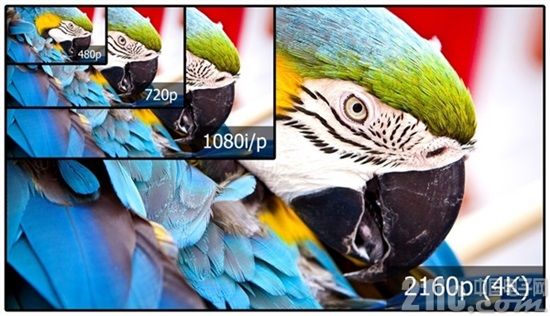The era of ultra high definition (UHD) displays is coming! Large streaming media companies such as YouTube, Netflix and Amazon Instant Video are starting to offer 4K content, and there is no doubt that more and more content will be available anytime, anywhere. For this reason, broadcast and professional video content providers will continue to upgrade their existing transport interfaces to meet the growing bandwidth demands of higher resolution video content (see Figure 1).
This article refers to the address: http://

Figure 1: High resolution video
If you are a system designer working on broadcast or professional video equipment such as video switchers, displays, routers, format converters or distributed amplifiers with Serial Digital Video Interface (SDI), you are likely to have considered The following three questions:
1. Transport interface: SDI or IP-based video (10 Gigabit Ethernet)?
For years, broadcasters and other content providers have used SDI for uncompressed video transmission and have formed a complete infrastructure to support their operation; however, IP (Internet Protocol) transmission over Ethernet interfaces is becoming more and more universal. An off-the-shelf IP solution reduces costs, provides a flexible infrastructure implementation = and increases the scalability of higher data rates, all thanks to Ethernet in data center and other communications infrastructure applications Popularity in the middle.
The Society of Motion Picture and Television Engineers (SMPTE) defines interfaces for 4K video transmission, SDI (ST-2082 for 12G-SDI) and 10G Ethernet (SMPTE-2022-5/6). There are also a handful of studio-based videos that are being transmitted via IP proposals, including Sony NMI, Evertz ASPEN, and AIMS, which are intended to take full advantage of SMPTE's standardized Managed Video Services Forum (VSF) TR-03/04. The choice of system interface depends on the target infrastructure on the market. In most cases, the system needs to support both interfaces that maximize the potential market and support interfaces that meet customer requirements for heterogeneous video networks. In such cases, it is wise to make your hardware design support both SDI and IP, and then use software to select the appropriate transport interface.
TI's LMH1218 cable driver and LMH1219 cable equalizer are the industry's first devices to support both SDI and 10G Ethernet data rates and electrical specifications in the same device.
2. Transmission medium: coaxial cable or fiber?
Higher speed data transmission using 12G-SDI (or 10 Gigabit Ethernet for IP video transmission) increases losses in the transmission medium and reduces the total communication cable length between the video source and the receiver. To cope with the insertion loss and high frequency jitter generated by 12Gbps, signal conditioning components such as equalizers, clock reformers, and cable drivers should be used to extend the length of the coaxial cable to 100 meters.
When a longer transmission distance is required, the fiber can be used as another transmission medium, but the system cost is also higher. When using common form factors, such as SFP+ (Enhanced Small Form Factor Pluggable), you can use components specifically designed to support out-of-order SDI video frames, including common ill-conditioned data, and compliance with SFF-8431 specifications, ie 10G Ethernet video based components transmitted over IP.
TI's LMH1218 cable driver and LMH1219 cable equalizer (both of which have a clock reformer) support a 75Ω interface for coaxial cable and a 100Ω SFF-8431 compatible interface for optical components in the same device. VIDIO, a 4K FMC development kit with LMH1218 and LMH1219, features 12G SDI (75Ω BNC) and IP (SFP+) interfaces with resolutions up to 4Kp60.
3. Transmission speed: 3G-SDI or 12G-SDI?
Currently, there are three ways to transfer 4K content via the SDI interface. One of the more stupid methods is to use 4 cable interfaces, each carrying 3G video data; the second method compresses 12G data to a single 3G interface; and the third method is to transmit uncompressed through the 12G-SDI interface. video.
Unless you are a provider of end-to-end solutions, or have the flexibility to market your 12G-SDI system design to the lower end, but still popular 3G-SDI market, you need to design multiple SKU (inventory unit) to meet different price expectations. The design team's time is already tight, and it takes extra time and effort to design and maintain multiple SKUs to support 12G-SDI and 3G-SDI interfaces. Reusing existing hardware designs and inserting SDI components for 3G-SDI or 12G-SDI on the production line, depending on the SKU being assembled, maximizes cost savings and optimizes performance.
TI's cable drivers (LMH1218 and LMH0318) are 100% pin compatible with cable equalizers (LMH1219 and LMH0324) and are available in the same package/pinout for easy upgrades.
Desktop Multi-function Adapter is suitable for any normal brands Laptop. Wall Multi-function Adapter is suitable for people who always travel any country. Its plug is US/UK/AU/EU etc. We can produce the item according to your specific requirement. The material of this product is PC+ABS. All condition of our product is 100% brand new.
Our products built with input/output overvoltage protection, input/output overcurrent protection, over temperature protection, over power protection and short circuit protection. You can send more details of this product, so that we can offer best service to you!
Multi-Function Adapter, 12W Wall Adapter, 30W Wall Adapter ,90W Desktop Adapter
Shenzhen Waweis Technology Co., Ltd. , https://www.waweisasdapter.com